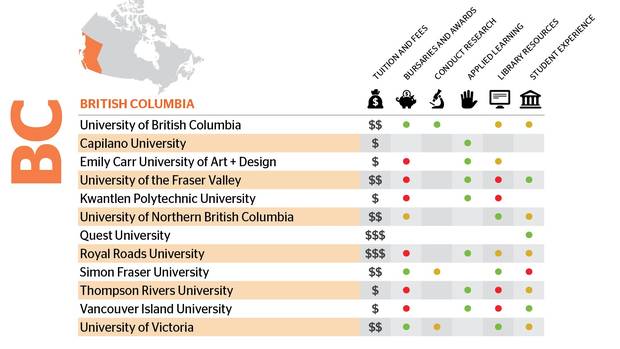The Globe and Mail’s Canadian university report profiles collected data from over 60 universities across Canada. This annual report lists the research conducted on several areas of student interest at the participating universities. The areas of focus range from education and social experience to cost of education.
The researchers talked to students, faculty, and university officials to investigate how the nation’s universities compare, what they offer, and how they’re unique.
According to the report, the researchers collected data on affordability, financial aid, library spending, student satisfaction, student retention, degree completion, student achievement, university reputation, research funding, and teaching awards. The data was collected from publicly available sources.
The breakdown of the research splits into six categories: cost, financial aid, research, applied learning, library resources, and student experience.
Starting with cost, the report lists UFV with a $6,082 tuition and categorizes the university within average costs ($$) range. However, this number is incorrect; the agreed upon figure is $5,071. Because designations for below or above average is a $300 difference, UFV would likely be considered below the provincial average for the cost of tuition and compulsory fees if placed with its actual cost.
For bursaries and awards offered, of the teaching universities that are similar to UFV, there is no ranking or the ranking is considerably below average. Only UVIC, SFU, and UBC — the established research universities are rated above average. UNBC, the fourth research university in B.C. sits at the province’s average.
Vladimir Dvoracek, associate vice president of institutional research and integrated planning at UFV said that the differences appear to parallel the type of university receiving the rating.
“The trend reflects the universities’ offerings as a research institution and age,” said Dvoracek. “A longer history means more graduates and potentially more donating alumni. Additionally, research institutions offer PhDs, which may allow for larger gifts to their alma mater.”
Although the research universities boast higher ratings in bursaries and awards, the reverse is true for applied learning offerings.
In terms of applied learning, none of the research universities rank on the scale. The rest of the public institutions (which excludes Quest, a private university) all score above average.
“If you look at the vision of [UFV], the number one thing it says is to provide the best undergraduate education in Canada,” said Dvoracek. “UBC’s vision is to be a world top 30 research university.”
These differences in ranking may reflect the vision of each institution.
Student experience is one of the categories where UFV also ranks above average. This category was based off a survey of senior students who were asked to evaluate their “entire educational experience.”
Eric Davis, UFV provost and vice president academic qualified the ranking of UFV.
“We always do really well on questions like quality of education, quality of the faculty, degree of interaction with faculty, things like that,” said Davis. “Where we do less well is on the community life at the university, but I think we do better now than we used to, partly because we’ve now got the SUB [Student Union Building].”
Davis acknowledged that the university is aware of the areas that it doesn’t rank as high in and said that the institution is always working to improve the university’s offerings.
“It’s useful to get these survey results because sometimes it reminds you that maybe you’re doing really well in one area and your students seem to be happy, but you’re not perfect and there are ways you can improve,” said Davis.


